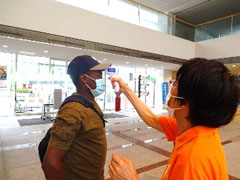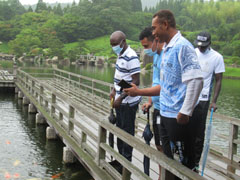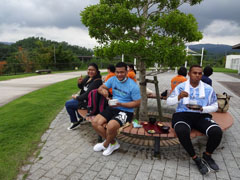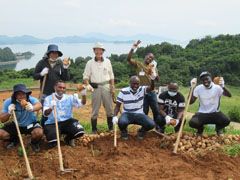Take measures against coronavirus and start the tour!
We held "Higashihiroshima Tour" on Thursday, July 9th. Six long-term participants and one family member who had already come to Japan before the spread of coronavirus infection joined the tour.
It was a tour using a big bus to prevent new coronavirus infection.
The participants who gathered in the morning successfully passed the temperature measurement and physical condition inspection. The weather forecast was cloudy with occasional rain. Actually, it was a start in a little light rain.

We have become accustomed to measuring body temperature, which is essential for events.
Enjoy watching the carp and take a walk through the flowers
Sankeien, our first destination, is a Japanese garden built in 1993 in line with the opening of Hiroshima Airport. When you step in from the entrance, you will be impressed by the wonderful Japanese landscape that spreads out in front of you! Participants were interested in it and asked "When was it built?" and so on. Many colorful Nishikigoi (colorful carp) swam in the pond and welcomed us. It seemed that the carp aimed at the bait given by visitors. When they looked at our silhouette, they began to fidget. When Mr. HABIMANA from Rwanda started feeding the carp, they made a fuss. Other participants took pictures of each other.
Countless coins were placed on the stone lantern in the middle of the pond. Seeing that, some participants were interested in the mysterious custom of Japan. Since the rain stopped, we went for a walk in the park. "Hanamatsuri"(Flower Festival), known for beautiful hydrangeas, had been held every year, but this year it was canceled due to the spread of coronavirus. However, even in July, hydrangea is still in full bloom. The flowers bloomed in a variety of colors and entertained the eyes of the participants.

The Japanese garden and the carp swimming in the pond were very popular!
Take a break at Fukutomi Dam
At lunchtime, we headed to the roadside station "Lakeside Village Fukutomi" near Sankeien. There are many playground equipments here, and it is a popular park crowded with families on weekends. It was a weekday, but there were many guests. Participants had lunch and rested at the shops and restaurants at the roadside station. Mr. SUKULU from Solomon Islands ordered a slightly gorgeous set meal. He seemed to like the braised rice cake(Warabi-Mochi) with the "Kinako" powder on it. "I am very curious about Kinako. What is it?" ("Kinako" is powder of soya bean.)
On the bus to Akitsu, we enjoyed a quiz about Higashihiroshima. Asked if Higashihiroshima city faces the sea or not, all participants answered "no" with confidence. "Akitsu, our next destination, faces the sea!", we explained showing a map.

We had a leisurely lunch outdoors.
Go straight to the south in Higashihiroshima City and dig potatoes, a specialty of Akitsu
Akasaki in Kidani, Akitsu-cho is a famous place for producing potatoes. Guided by Mr. Arita of Arita Gardening Farm, our large bus had to take a narrow path. Thanks to driver's brilliant handling of the wheel, we managed to go through it.
On the way up to the farm, we looked back at the ocean behind. We were told about the oyster and the pearl oyster raft for raising pearl babies. Akitsu is famous for oyster farming. In addition, the pearl oysters are grown in gentle, clean seawater there until they grow large. Pearls, a specialty of Ehime Prefecture, are raised in Akitsu as a child. The water of Akitsu that flows into the sea through the potato fields is rich in nutrients and is useful for the growth of shellfish.
On the hillside overlooking the sea of Akitsu, lush potato fields are spreading. We first mowed the potato leaves and then dug out the potatoes. A lot of potatoes came out of the orangey soil that Mr. Arita is proud of. Despite the rain in the morning, the soil wasn't heavy, and it was partially dry. Some participants asked questions with interest such as "Do you grow potatoes by sowing seeds?" "How do you grow them?". "This soil resembles the color of the soil in my country," said Mr. CISS from Senegal. "In the future, I would like to spread Japanese potato in my country!" We packed some potatoes in bags, and brought them back as souvenirs. Our potatoes were cooked at "RACCOLT" restaurant in Hiroshima International Plaza, and we had it served as one of the dinner menus.
This tour was originally scheduled to be held on the following day Friday. But according to the weather forecast, it was going to rain on that day, so it was decided to be carried out one day early. We would like to thank the bus staff and Arita Garden Farm for their cooperation in changing the plan! We were able to spend a pleasant day learning the culture and industries around Higashihiroshima City without rain.

We got a lot of good potatoes!




scroll